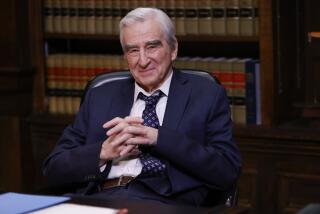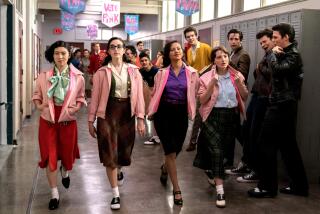‘ER’ calls its time of death
With its technical innovations and reliance on realism, “ER” changed dramatic television. And when NBC pulls the plug on the show Thursday after 15 seasons, “ER” will leave behind a splintered prime-time landscape as the networks struggle to compete in a digital world.
Set in a frenzied Chicago emergency room where the staff had personal lives often even more hectic than their medical cases, “ER” on its 1994 premiere was a dramatic innovation, a hyper-realistic “General Hospital” complete with gallons of blood, relentless Steadicam shots and shouted healthcare jargon. The audience loved it. “ER” was TV’s No. 1 drama in the ad-friendly category of adults ages 18 to 49 for an astonishing 10 seasons and has long served as the 10 p.m. anchor of NBC’s once-invincible Thursday lineup. Despite its age, the show has still sometimes beaten competing dramas in its time slot this season.
“I can’t say never, but I doubt we will ever see the likes of a show like ‘ER’ again that rounds up such a huge amount of viewers who watch something at the same time,” said Neal Baer, a Harvard-trained physician who was one of the show’s early writers and eventually served as an executive producer. “It’s truly the end of an era of television.”
“ER” was more than just a hit, though. Expanding on the realism of such groundbreaking 1980s dramas as “Hill Street Blues” and “St. Elsewhere,” “ER” in turn started a creative movement toward lifelike authenticity in specialized settings that has deeply influenced later hits such as the forensics-themed whodunit “CSI: Crime Scene Investigation” and the White House drama “The West Wing.” In real life, “ER” even inspired more students to study emergency medicine, and at least one study found it helped educate consumers about healthcare.
“ER” fans are thus bidding farewell to a lot more than just Dr. Tony Gates (John Stamos) and his colleagues at the fictional County General Hospital.
Indeed, “ER’s” life span has coincided with a deep commercial and cultural decline for the broadcast networks. Cable outlets stole market share and media attention with gritty dramas such as “The Sopranos” and “The Shield.” Increasing numbers of viewers are watching programming on the Internet or on a time-delayed basis using digital video recorders. Pressured by low ratings and rising production costs, broadcasters are turning to relatively inexpensive reality series and talk shows.
Next season, in a dramatic symbol of the networks’ ebbing fortunes, “ER’s” slot -- where it had the longest reign in the same one-hour time period of any scripted drama in network history -- will be occupied by Jay Leno’s Monday-to-Friday talk show. Leno’s program is reportedly expected to cost less than $2 million for a week’s worth of shows; for this season, NBC has paid Warner Bros. Television, the studio that produces “ER,” an estimated license fee that is nearly twice that figure for each episode of the hospital drama.
“That was certainly part of the DNA of NBC, award-winning, audience-grabbing quality drama,” said Warren Littlefield, who was NBC’s entertainment president when “ER” went on the air. The drama’s finale “ends that 10 o’clock era.”
It may end it for NBC at least, but not necessarily for the other broadcasters. ABC and CBS remain committed to the notion of 10 p.m. dramas and have publicly challenged the wisdom of NBC’s move. (Fox’s prime-time schedule ends at 10 p.m.)
“I will bet anybody who would like to bet that ‘CSI: Miami’ on Monday will beat Jay by a lot,” CBS chief Leslie Moonves said at a news conference in December, referring to one of his network’s popular procedural dramas. “We view it as a plus for us. It’s taking the third competitor out of the marketplace, and that will make us stronger.”
Yet even the most optimistic network insiders admit that the 10 p.m. landscape is a much more punishing environment for broadcasters than it was when “ER” premiered.
Low expectations
In retrospect, “ER’s” success may seem preordained, but at the time it made for an unlikely TV hit. Bestselling novelist Michael Crichton, who died last year at age 66, had written the original script as a movie screenplay based on his experiences as a Harvard medical student. But the script had languished unproduced for years before it was pitched to NBC as a series. Steven Spielberg, whose teaming with Crichton had met with great success on “Jurassic Park,” was initially onboard as a producer (his company Amblin Television is a partial owner of the show).
“It was a huge screenplay,” Littlefield recalled. “Characters all over the place, really dense. Unlike anything I’d ever read before.”
“L.A. Law,” the slick legal series that had been NBC’s signature drama during the late 1980s, was aging. So the network decided to take a gamble on a risky new drama. But the screening of the two-hour “ER” pilot for NBC brass did not go smoothly. The long, hand-held camera shots would discombobulate viewers, some executives feared. There was way too much gore for a prime-time show. And what was with all the medical nomenclature and slang, those urgent references to thromboses and tibias and tox screens as doctors raced through corridors? There was no way ordinary viewers would put up with all that.
“We were trying to show people that you don’t actually have to understand what they’re talking about to know what they’re talking about,” said John Wells, a veteran writer-producer who has served as an “ER” executive producer since the show’s creation. “That was a very difficult concept to get across. We kept saying, ‘Look, there’s an emotional undercurrent to all of these scenes that the audience is going to understand. They don’t really have to understand what a thrombosis is to understand what’s happening in the scene.’ ”
The behind-the-scenes disagreements led to “lots of yelling,” Wells recalled with a chuckle. But the creators ultimately got their way and “ER” earned a spot on the fall 1994 schedule, premiering three days before the launch of what would become another NBC smash, the sitcom “Friends.”
After the premiere, the ensemble of previously obscure actors became instantly famous. That was especially true of George Clooney, who played the womanizing lout Dr. Doug Ross, who usually redeemed himself with last-minute rescues of critically ill patients. Clooney, who left the series a decade ago to pursue movie stardom, recently returned for a ratings-grabbing pre-finale guest shot. Like “Law & Order,” another long-running NBC drama, “ER” has survived the exits of numerous cast members, including Anthony Edwards, Julianna Margulies, Eriq La Salle and Noah Wyle.
The cast was hardly the show’s only distinctive feature, however. The producers made extensive use of a Steadicam, a contraption that allowed a moving operator to control a mounted camera with little or no visible motion on the film. Even though the camera is hand-held, the shot looks fluid on-screen, as if it were made using a camera mounted on a dolly -- an option that typically drives up production costs.
Steadicams had been used since the 1970s in such films as “Rocky” and “Bound for Glory.” But “ER” exploited the technology as never before, for rambling tracking shots that captured all the chaos of the emergency room in one long take. Three-quarters of the scenes in Season 1 were shot using Steadicams, an unprecedented percentage for network TV, according to one estimate.
“Suddenly, you could be on the fly with these doctors running down the hallways,” Baer said of the Steadicam scenes. The technique became a staple of TV production, used on a wide range of series, including “Battlestar Galactica” and “Curb Your Enthusiasm.”
“ER” also made effective use of real-life physicians on its writing staff, including Baer and Lance Gentile, whose “Love’s Labor Lost” episode from 1995 won an Emmy for writing. Putting such specialists on a show’s writing staff was considered unusual at the time. But “ER’s” immersion in medical lingo and techniques convinced TV executives that viewers could handle forays into previously arcane worlds ruled by characters with rare expertise. That paved the way for the “CSI” franchise and its many procedural cousins. “The West Wing” hired several writers with high-level political backgrounds, including Lawrence O’Donnell, a former U.S. Senate committee chief of staff during the Clinton administration.
“We were trying to say that there was an artifice in a lot of what was on the air and that the audience knew there was an artifice to it,” Wells said of “ER.” “And that we were going to do something that looked different from that and was different from that.”
In that goal, “ER” may have been too successful. “Of course it had its own created artifice, and over the years it’s become its own cliche,” Wells said.
TV producers often have trouble letting go of their shows, but Wells firmly believes it’s time for “ER” to say goodbye. Even so, he can’t resist feeling a twinge of sadness. Not just at losing the show after 15 years but at seeing quality scripted TV lose its honored 10 p.m. spot on the schedule at NBC -- and soon, perhaps, at other networks.
“I’m saddened that that’s not going to be a drama slot anymore because it’s been a terrific one for many, many years,” he said. “And I think there is still an audience that wants to watch dramas at 10 o’clock.”
More to Read
The biggest entertainment stories
Get our big stories about Hollywood, film, television, music, arts, culture and more right in your inbox as soon as they publish.
You may occasionally receive promotional content from the Los Angeles Times.











